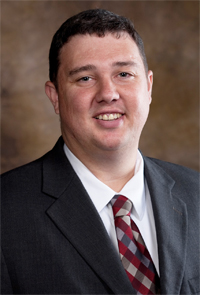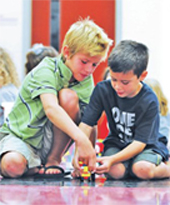Department of Industrial Engineering
4207 Bell Engineering Center
1 University of Arkansas
Fayetteville, AR 72701
Phone: (479) 575-3156
Fax: (479) 575-8431
Campers At Springdale's Sonora Elementary Learn Problem Solving Skills

Engineering Teaches Children That Problem Solving Is A Process
Joss Jongewaard said he learned problem-solving skills and to not give up while working on camp activities.
The camp Joss, 8, is attending this week is an annual program that's part of the Environmental And Spatial Engineering Program at Sonora Elementary School. This year's theme is engineering, said Josh Worthy, program facilitator. It's the third year of the camp, and attendance doubled from last year, Worthy said. There are 50 campers this year. Most of the students are from Sonora Elementary.
Engineering is a good method for teaching problem-solving skills because it's a hands-on way of learning, said Chase Rainwater, assistant professor of industrial engineering at the University of Arkansas. Rainwater also works with high school students in Springdale on engineering projects.
Engineering teaches children that solving problems is a process, Rainwater said. They learn from each attempt and alter what they're doing to try again. "It's perfectly fine that the first version doesn't work," he said.
Worthy stood in the school's hallway Wednesday morning surrounded by kids ages 5 to 12. They worked on structures made of dry spaghetti and marshmallows. The goal was to get the structures to stand on their own.
 "If it doesn't work the first time, what do you do?" Worthy asked the group.
"If it doesn't work the first time, what do you do?" Worthy asked the group.
"Try again," the children replied.
"And in a different way," Worthy clarified. "That's engineering."
The children do team building exercises, like the one with spaghetti and marshmallows, every morning. They then split into two groups and work on activities that involve Legos and computer software.
Elizabeth Ellis, 8, sat on the floor working on a car made of Legos. She said it was challenging because the goal was to get the car to move using a balloon. It took a couple of tries, but she figured out she could blow up the balloon and let the air out to make the car go forward.
A group of students worked on 3-D design software, while Worthy worked with Leah Becker, 10, on the program's new 3-D printer. Leah wanted to print a model of the Death Star from the "Star Wars" movies to give to her father. She said her favorite part of the process is finding and creating designs to print with the machine.
Willow Jongewaard has four children attending camp and was helping there on Wednesday. She said she's seen a difference in her children's problem-solving skills since starting the camp. Her oldest son wanted to buy a Transformers toy, but it was too expensive. He decided to create one out of Legos instead.
The camps have been paid for through grants for the past three years, Worthy said. Student demand will determine if a camp is held next year. If there is a camp, one theme could be the use of technology in the culinary field.
Release date: 8/7/2014